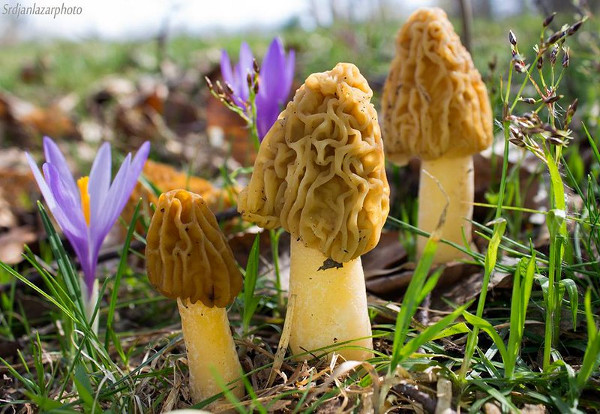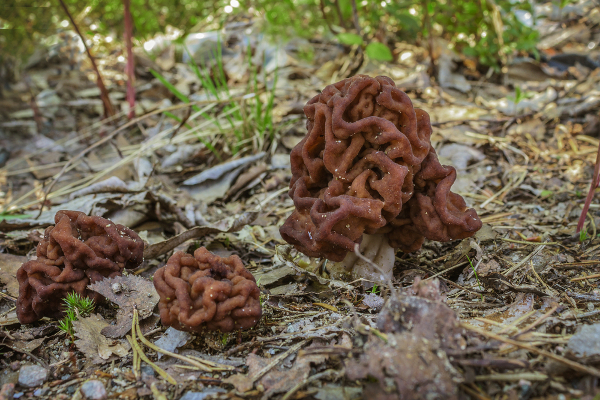Distinguishing between real morels and false morels is a significant task for enthusiasts and foragers exploring the realm of fungi. The differences between these species go beyond appearances, delving into their essence.
Recognizing the subtle characteristics of each enhances foraging skills and reveals the intricacies of nature’s design, fostering a deeper appreciation for mycology.
Morphological Differences
Distinguishing between real morels (Morchella genus) and false morels can be done by examining their unique morphological features. Real morels have a cap with a honeycomb-like network of pits and ridges, while false morels have a wrinkled or brain-like cap surface.
Real morels have a hollow, centrally attached stem, whereas false morels have a solid or chambered stem that is often off-center. The spore-bearing surface of real morels is within the cap pits, while false morels have spores on the outer surface of the ridges.
Real morels are symmetrical in shape, with proportionally aligned caps and stems, while false morels can have irregular forms. By observing these characteristics, foragers can confidently differentiate between real morels and potentially toxic false morels.

Habitat and Growing Conditions
Real morels, from the Morchella genus, thrive in orchards, woodlands, and disturbed areas like recently burned sites. They prefer well-drained soils and are often found near trees such as ash, elm, and apple. In contrast, false morels like Gyromitra esculenta, are commonly found in forests, woodlands, and areas with rich, damp soils. They may also be spotted in disturbed habitats like old apple orchards or burned areas. Here is a comparison of the habitat preferences for real morels and false morels:
| Aspect | Real Morels | False Morels |
|---|---|---|
| Habitat | Orchards, woodlands, disturbed areas | Forests, woodlands, damp soils |
| Soil Preference | Well-drained soils | Rich, damp soils |
| Tree Associations | Ash, elm, apple trees | – |
Time of Appearance
Distinguishing between real morels and false morels is often based on the timing of appearance. Real morels usually emerge in the spring, during cool and damp conditions, while false morels tend to appear in the fall.
Recognizing these distinct growth periods is key for accurate identification and safe foraging practices.
Spring Morels
Spring morels, with their conical or sponge-like caps ranging from light tan to dark brown, typically emerge in early to mid-spring. These prized fungi, found near dead or dying trees in deciduous forests, grow to heights of 2-4 inches.
Highly sought after for their unique flavor, spring morels are a culinary delight but must be cooked before consumption.

Fall False Morels
Fall false morels, from the Gyromitra genus, emerge in autumn with wrinkled caps, often found under hardwood trees or in grassy areas.
Unlike true morels in spring, these toxic mushrooms pose health risks if consumed, emphasizing the need to differentiate between the two.
Recognizing the seasonal differences is also important for safe mushroom foraging.

Cap and Stem Characteristics
Real morels can be distinguished from false morels by their cap and stem characteristics. Real morels have deeply pitted and ridged caps, resembling a honeycomb, which are attached directly to the stem for a seamless look.
In contrast, false morels have wrinkled or lobed caps, giving a brain-like appearance, and the caps are loosely attached to the stem.
The stems of real morels are hollow and centrally located, running the entire length of the cap and matching its color. False morels, on the other hand, have stems filled with cotton-like material, making them solid, and the stems can be irregularly shaped, sometimes wrinkled or chambered.
Spore Print Analysis
Spore print analysis is essential for distinguishing real morels from false morels by examining the color of their spores. True morels typically produce spore prints in pale cream to yellowish-brown, whereas false morels can have spore prints ranging from brown to pink or purplish-brown. This method allows for accurate identification, helping to differentiate true morels from potentially harmful false morels.
Identifying True Morels
To differentiate between real morels and false morels, analyze the spore print colors. True morels have light-colored spore prints, varying from creamy white to yellowish.
To conduct the analysis, gently detach the cap from the stem, place the cap with the gills facing down on paper, cover it with a glass to preserve humidity, and wait for a few hours.
The spores will drop onto the paper, revealing their color, aiding in the accurate identification of true morels.
Differentiating False Morels
False morels can be distinguished from true morels by examining their spore print colors. True morels have light-colored spore prints, ranging from creamy white to yellowish, while false morels have darker spore prints in shades of brown, purple, or black.
Analyzing the spore print color helps mushroom foragers differentiate between safe and edible true morels and potentially harmful false morels.
Toxicity and Health Risks
The toxicity and health risks associated with consuming false morels are a significant concern for foragers and mushroom enthusiasts. False morels contain the toxin gyromitrin, which can lead to symptoms ranging from gastrointestinal discomfort to severe poisoning. Gyromitrin breaks down into monomethylhydrazine (MMH) in the body, a compound found in rocket fuel that can cause liver and kidney damage, seizures, and even death. Here are the key differences between false morels and true morels:
| Aspect | False Morels | True Morels |
|---|---|---|
| Toxicity | Contains gyromitrin toxin | Generally safe for consumption |
| Cap Shape | Wrinkled or lobed | Honeycomb-like structure |
| Stem Attachment | Attached at the top of the cap | Attached at the bottom |
Differentiating between false and true morels is vital to avoid potential health hazards.
Harvesting Guidelines
Understanding the proper methods for harvesting morel mushrooms is key for a safe and fruitful harvest. Morels are highly prized for their unique flavor and texture, making them a sought-after delicacy for culinary enthusiasts. Follow these guidelines for sustainable and safe harvesting:
- Timing: Harvest morels in the spring, typically between March and May.
- Cutting Technique: Use a sharp knife to cut the morel at the base, preserving the root.
- Storage: Keep morels in a paper bag in the refrigerator for freshness.
- Cleaning: Soak morels in saltwater to remove debris and insects.
- Sustainable Harvesting: Only pick mature morels, leaving smaller ones for future growth.
Cooking and Culinary Uses
When preparing morel mushrooms, knowing key cooking methods can enhance their deliciousness. Morels have an earthy, nutty flavor and meaty texture, making them a sought-after ingredient. Here are three tips to bring out their best qualities:
- Dry Saute: Clean morels, slice vertically, and dry sauté in a hot pan with butter for intensified flavor and caramelization.
- Creamy Sauces: Pair morels with creamy sauces like morel cream sauce for pasta or morel-infused béchamel to complement their earthiness.
- Simple Preparations: Opt for simple sautés with garlic and herbs or light batter frying to let morels’ unique flavor shine.
Conservation and Sustainability
Conservation and sustainability are necessary for the sustainable harvesting of morel mushrooms. Morels contribute significantly to the ecosystem, and their sustainable harvest is needed for maintaining biodiversity and ecosystem health.
To achieve this, it is important to:
- Establish Harvesting Limits: Setting limits on the amount of morels that can be harvested in a specific area to prevent overexploitation and ensure reproduction.
- Protect Habitats: Protecting sensitive habitats where morels grow from deforestation, pollution, and other harmful activities to maintain ideal conditions for their growth.
- Promote Regenerative Practices: Encouraging regenerative harvesting techniques, like leaving some morels to spread spores, to sustain morel populations for future generations.



